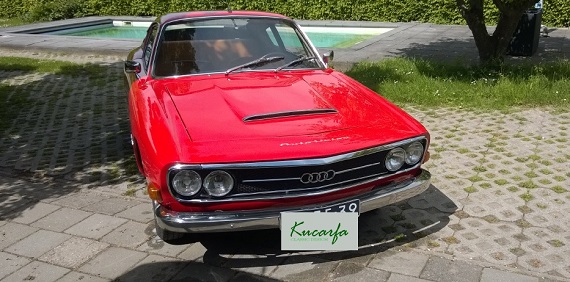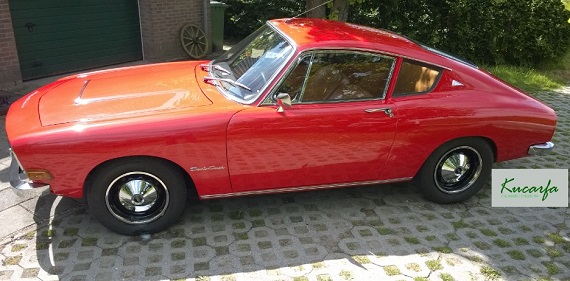For some time, the fate of Audi seemed sealed. Post World War II, Auto Union GmbH’s production was focused on the DKW automobiles that fit into the European economic situation much better than the pre-War luxury cars from Horch and Audi. But the market was changing, and Auto Union launched the very pretty 1000SP Coupe and Convertible. But, there was no denying that the 1000SP looked like a 1950s car in a 1960s world. Audi’s production would really have to wait until the launch of the C1 chassis in 1968; prior to that, some re-badged DKW models wore the Audi name but sold only in small numbers. The C1 would prove to be a pretty popular model, though, and the new 100 model would be available as both a sedan and as a 2-door “Coupe S” model. The lines of that model, as with the 1000SP, mimicked more expensive and famous cars such as the Fiat Dino and Aston Martin DBS. It was a pretty large departure from the mini-Thunderbird look of the 1000SP and much more modern. But, it appears that there may have been a missing link developed in the mid-1960s:
Warning!
We have 15 years of archives. Links older than a year may have been updated to point to similar cars available to bid on eBay.Tag: Auto Union
The world of Auto Union is full of paradox. That the company even came into existence is itself somewhat of a fluke, but a harsh economic situation in Germany in the 1930s led four mostly failing companies to band together in the hope that united, they might survive. Out of that union was born the image of the four rings that today are worn proudly by the last remnant, and the least successful, of the original four – Audi. If that isn’t strange, the history of how we got to that point certainly is. Only one of the companies was truly successful when they banded together, and they produced primarily motorcycles, not cars. Yet only one year after being founded, the fledgling company put its technical prowess up against the might of the most storied car company in the world – indeed, the inventors of the automobile – Daimler-Benz. And by “its” technical prowess, I mean the technical prowess of one Ferdinand Porsche, himself an outcast of sorts from several car companies. His design was both unorthodox and unusual, with a single-cam supercharged 16 cylinder engine mounted in the middle of the car. Mind you, this was a full 25 years before Cooper would make the “revolutionary” change that would be the accepted practice of all modern Formula One cars. With entirely new suspension designs and strange handling behaviors – never mind enough torque to jump start an industrial production line and tires that would consequently disintegrate immediately or fuel that was really just a high explosive in liquid form – the Auto Union Grand Prix cars shared nothing in common with the road-going models marketed by the company, who at the start of the 1930s didn’t even produce what could loosely be identified as a sports car.
Yet, it worked.
Auto Union may numerically have not won as many races as Mercedes-Benz did over the same period, but they established themselves on the same level – no small feat, considering the company. They won races, championships and set records and were primed with new luxury, smart economy and even sports vehicles to capitalize on their great success at the race track and in the record books. And then, World War II broke out, and as fate would have it Auto Union’s primary headquarters were in Saxony. For those of you who aren’t particularly fond of maps, Saxony happens to be exactly where the Russians ended up advancing into in 1945. Mired in what would become East Germany, there didn’t appear to be much hope for Auto Union and it seemed they were relegated to the history books. But in 1949 the company was relaunched, now based in Ingolstadt – not far from its old rivals. The brand that had previously been the bread and butter of Auto Union’s sales – DKW – would carry the four rings and continue to make economy cars, but little else remained from the former glory of Auto Union. Indeed, even DKW itself was full of contradictions; the name derived from “Steam Powered Car” in German (Dampf-Kraft Wagen), yet the company hadn’t produced a steam car since the late teens. Their current lineup continued the strange trend with oxymoronic names like “3=6”. Math not being their strong suit, DKW alternatively called the car F900, F91, and finally “Sonderklasse”, though there was no longer a non-Sonder model. The underpinnings would make Swedes smile, with a two-stroke inline-3 powering the front wheels. And from these modest bones the only officially badged “Auto Union” was created – the 1000SP. With a bit more power and styling borrowed from an American classic, it was a special car:
CLICK FOR DETAILS: 1961 Auto Union 1000SP Coupe on eBay
2 Comments
Start of the 1939 German Grand Prix with Auto Union Type D and Mercedes-Benz W154 M163s – their last meeting in the nation of their birth
Yesterday saw an interesting comparison in racing; in F1, Mercedes-Benz once again dominated the field with seeming ease, dictating the pace and watching the strategy of its competitors from Maranello. While truth told my focus remained squarely on the Formula 1 race, there were several other popular race series running concurrently; both wildly popular Moto GP and World Endurance Championship races were contested as well. Notably, Audi won the WEC Silverstone 6-hour contest, continuing its quite remarkable run in endurance series amidst rumors that they could be heading to Formula 1. The question posed by me in my conclusion to the investigation of the Silver Arrows period is simply if the racing was necessary? There were other options in terms of racing for both companies to explore, and indeed they could also have taken the Opel strategy in no racing at all. Did the companies choose the right route?
I’d like to take this opportunity to thank our readers for the positive feedback to this feature. It’s been wonderful for me to revisit this research and have the enthusiast community enjoy it. I’d also like to thank Dan and Paul at GCFSB for not only affording me the opportunity to put this research up, but indeed for encouraging me to do so. Though they’re not likely to be paying attention I’d like to thank the Saxony State Archives in Chemnitz and the staff at the Mercedes-Benz factory archives, both of which were very welcoming and accommodating during my time there. Lastly, I’d like to thank my family who has been both encouraging and patient while I’ve spent countless hours working on this site. Without further ado, please enjoy the conclusion!
CONCLUSIONS : WAS RACING NECESSARY?

A 1936 Auto Union Type C sits below a similarly streamlined Junkers JU-86 at an exposition
As we saw in the last few installments, Daimler-Benz and Auto Union had heavily engaged in racing – a massive investment for both, pushing the boundaries of existing technology and redefining how motor racing was to be undertaken. The question in today’s installment was who this methodical approach to racing benefited the most. Was the government’s investment in racing worthwhile? Was Auto Union’s gamble on building an unconventional race car a success? Were the extremes to which Daimler-Benz was willing to stretch its racing budget realized in results over the competition? Today we look at some of the more pragmatic reasons behind the motivations of both companies and some of the ideology behind government which helps explain the involvement of both.
Link To Part 4
FIVE: FOR COMPANIES, GOVERNMENT, COUNTRY?
If you’ve been following my 6-part documentary on the Silver Arrows, you’ve seen the four rings of the Auto Union pop up. Now synonymous with Audi, the Auto Union was in fact four different companies that banded together, much like the Volkswagen Group of today. Like the Volkswagen Group, they had a range of cars; Horch for ultra-luxury, Audi was the sportier gentleman’s car, Wanderer covered the middle range and the entry level products and motorcycles were covered by DKW. All of the companies, independently, had significant history, but as we’ve seen in the Silver Arrows documentary, the depression years in the 1920s and 1930s meant that just like Daimler and Benz, the Auto Union was a partnership formed out of necessity for survival in a market where few cars sold. However, as we’ve also seen, the massive investments in infrastructure and breaks on taxes meant that the automobile industry was experiencing a big push by the mid 1930s, coupled with new technology and aerodynamic designs. One of the most promising designs for the Auto Union was the DKW F9; a versatile, aerodynamic small car, it resembled the KdF “Volkswagen” (Beetle) prototypes but was more refined. However, the outbreak of the war stalled the project, slated to launch in 1940. As with other similar projects by German automobile companies, the remnants of the company picked up the project in the late 1940s, and the “new” DKW F91 project rolled out in 1953 as the DKW 3=6 “Sonderklasse”. With a .9 liter two stroke inline-3, the performance wasn’t going to shock you but it was a cleverly packaged car and sold well. It was replaced in the late 1950s by an updated version, now named the Auto Union 1000; updated lightly and with more power from the now 1.0 liter motor, it was available in 5 different configurations and was the basis for the much loved but rarely seen 1000SP roadster – the mini-Thunderbird. Today’s example is an interesting 1962 coupe that apparently was converted into a cabriolet at some point:







